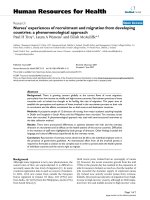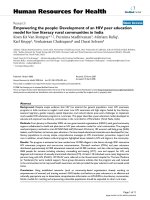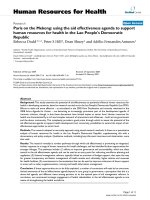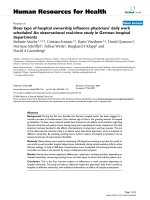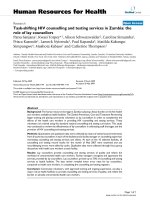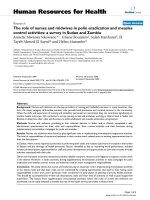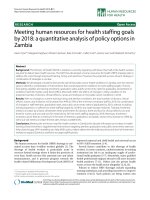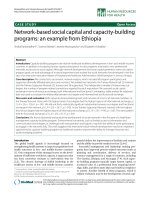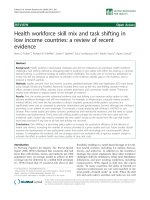Báo cáo sinh học: "MiRNA-205 modulates cellular invasion and migration via regulating zinc finger E-box binding homeobox 2 expression in esophageal squamous cell carcinoma cells" pptx
Bạn đang xem bản rút gọn của tài liệu. Xem và tải ngay bản đầy đủ của tài liệu tại đây (543.38 KB, 12 trang )
RESEARCH Open Access
MiRNA-205 modulates cellular invasion and
migration via regulating zinc finger E-box binding
homeobox 2 expression in esophageal squamous
cell carcinoma cells
Kayoko Matsushima
1†
, Hajime Isomoto
1,2*†
, Naoyuki Yamaguchi
1,2
, Naoki Inoue
1
, Haruhisa Machida
1
,
Toshiyuki Nakayama
3
, Tomayoshi Hayashi
3
, Masaki Kunizaki
4
, Shigekazu Hidaka
4
, Takeshi Nagayasu
4
,
Masahiro Nakashima
5
, Kenta Ujifuku
6
, Norisato Mitsutake
6
, Akira Ohtsuru
6
, Shunichi Yamashita
6
, Manav Korpal
7
,
Yibin Kang
7
, Philip A Gregory
8
, Gregory J Goodall
8
, Shigeru Kohno
2
and Kazuhiko Nakao
1
Abstract
Background: Esophageal squamous cell carcinoma (ESCC) is often diagnosed at later stages until they are
incurable. MicroRNA (miR) is a small, non-coding RNA that negatively regulates gene expression mainly via
translational repression. Accumulating evidence indicates that deregulation of miR is associated with human
malignancies including ESCC. The aim of this study was to identify miR that could be specifically expressed and
exert distinct biological actions in ESCC.
Methods: Total RNA was extracted from ESCC cell lines, OE21 and TE10, and a non-malignant human esophageal
squamous cell line, Het-1A, and subjected to micro array analysis. Expression levels of miR that showed significant
differences between the 2 ESCC and Het-1A cells based on the comprehensive analysis were analyzed by the
quantitative reverse transcriptase (RT)-PCR method. Then, functional analyses, including cellular proliferation,
apoptosis and Matrigel invasion and the wound healing assay, for the specific miR were conducted. Using ESCC
tumor samples and paired surrounding non-cancerous tissue obtained endoscopically, the association with
histopathological differentiation was examined with quantitative RT-PCR.
Results: Based on the miR microarray analysis, there were 14 miRs that showed significant differences (more than
2-fold) in expression between the 2 ESCC cells and non-malignant Het-1A. Among the significantly altered miRs,
miR-205 expression levels were exclusively higher in 5 ESCC cell lines examined than any other types of malignant
cell lines and Het-1A. Thus, miR-205 could be a specific miR in ESCC. Modulation of miR-205 expression by
transfection with its precursor or anti-miR-205 inhibitor did not affect ESCC cell proliferation and apoptosis, but
miR-205 was found to be involved in cell invasion and migration. Western blot revealed that knockdown of miR-
205 expression in ESCC cells substantially enhanced expression of zinc finger E-box binding homeobox 2,
accompanied by reduction of E-cadherin, a regulator of epithelial mesenchymal transition. The miR-205 expression
levels were not associated with histological differentiation of human ESCC.
Conclusions: These results imply that miR-205 is an ESCC-specific miR that exerts tumor-suppressive activities with
EMT inhibit ion by targeting ZEB2.
* Correspondence:
† Contributed equally
1
Department of Gastroenterology and Hepatology, Nagasaki University
Hospital, 1-7-1 Sakamoto, Nagasaki 852-8102, Japan
Full list of author information is available at the end of the article
Matsushima et al. Journal of Translational Medicine 2011, 9:30
/>© 2011 Matsushima et al; licensee BioMed Central Ltd. This is an Open Access article distributed under the terms of the Creative
Commons Attribution License ( which permits unrestricted use, distribution, and
reproduction in any medium, provided the original work is properly cited.
Background
Esophageal cancer is the eighth most common cancer
and the sixth most common cause of cancer deaths
worldwide [1]. Although Barrett’s adenocarcinoma is the
most rapidly incr easing cancer in Western countries [2],
esophageal squamous cell carcinoma (ESCC) is still
dominant in East Asia, including Japan [3]. ESCC is
often diagn osed at later stages, so that the prognosis of
affected patients is unsatisfactory, despite the develop-
ment of therapeutic options such as surgery, chemother-
apy, and radiotherapy [4]. Consequently, there is a great
need for biomarkers to al low a tailored multimodality
approach with increased efficacy. To date, nevertheless,
efforts to indentify molecular markers in a ssociation
with the pathogenesis of ESCC have proved to be essen-
tially unsuccessful [5].
MicroRNAs (miRs) are small, non-coding RNAs that
negatively re gulate gene expression via translati onal
repression or messenger RNA degradation. More than
700 miRs have been identified and registered in humans,
with each individual miR predicted to target multiple
genes based on the seed sequence matches in their
3’-untranslated regions (UTRs) [6]. MiRs are involved in
biological and pathologic processes, including cell differ-
entiation, proliferation, apoptosis, and metabolism [7],
and they are emerging as highly tissue-specific biomar-
kers with potential clinical applicability for defining can-
cer type and origin [8,9]. Accumulating evidence
indicates that deregulation of miRs is associated with
human malignancies and suggests a causal role of miRs
in tumor initiation and progression, since they can func-
tion as oncogenes or tumor suppressors [10]. In fact,
previous studies showed distinct differences in miR
expression patterns between squamous cell carcinoma
and adenocarcinoma in esophageal and other cancers
[3,11,12]. Kimura et al. reported that miR-205 showed
highest expression in both benign and malignant squa-
mous epithelia including ESCC, although it was less
expressed in cell lines and tissues other than squamous
epithelia. On the other hand, miR-21, which is an onco-
genic miRNA in various malignancies, was also up-
regulated in ESCC compared to paired normal squamous
epithelia [13]. However, there has been little information
on the functional roles of miRs specific for ESCC [14].
Epithelial to mesenchymal transition (EMT) describes
the m olecular reprogramming and phenotypic changes
involved in the conversion of polarized immotile epithe-
lial cells to motile mesenchymal cells [15]. EMT occurs
during fundamental biological and disease processes
including development and cancer [16]. EMT in cancer
leads to the loss of cell-cel l adhesion and cell polarity as
well as altered cell-extracellular matrix interactions,
resulting in invasion and metastasis [16]. E-cadherin is a
central component of the adherens junction complex
responsible for calcium dependent cell-cell adhesion
and maintenance of cytoskeletal organization [15,16].
Loss of E-cadherin expression can be a common marker
of EMT and has been identified as a causal factor in
cancer progression [15,16]. Transcriptional repression of
the E-cadherin gene is emerging as an important
mechanism through which E-cadherin is downregulated
during tumor progression and such factors as snail,
slug/snail2, zinc finger E-box binding homeobox (ZEB)
1 and ZEB2 have been shown to directly bind to the E-
cadherin promoter and repress its transcription [15].
Several recent studies have identified miR-200 family as
key regulators of EMT and enforcers of the epithelial
phenotype [17,18]. In fact, the miR-200 f amily partici-
pates in a signaling network with the E-cadherin tran-
scriptional repressors ZEB1 and ZEB2. Using microRNA
target prediction algorithms, ZEBs were predict ed to
contain multiple sites for miR -200 family and in repor-
ter assays their 3’ UTR was functionally responsive to
the manipulation [15-17]. In addition, two miR-205
binding sites were indentified in ZEB2 [15,17], suggest-
ing EM T could be also regulat ed by miR-205 . The pre-
sent study was designed to identify miRs that could be
specifically expressed and exertdistinctbiological
actions in ESCC cells.
Methods
Cell lines and cultures
I) Five cell lines of human ESCC cells (OE21, TE5, TE8,
TE10, and TE11), a non-malignant human esophageal
squamous cell line immortalized by SV40 infection, Het-
1A, 2 human Barrett’s adenocarcinoma cell lines (Bic-1
and Seg-1), 3 human gastric adenocarcinoma cell lines
(AGS, AZ521 and KATOIII), 2 colorectal adenocarci-
noma cell lines (Caco-2 and DLD1), a human cervix
epithelioid carcinoma cell line (HeLa), a human lu ng
adenoca rcinoma cell line (A549), and human hemato lo-
gical malignant cell lines (acute promyelotic leukemia,
HL60; human T cell l ymphoblast-like cell line, Jurkat;
and histiocytic lymphoma, U 937) were cultured. The
AZ521, KATOIII, DLD-1, HeLa, A549, HL60, and U937
cells were purchased from the Japanese Collection of
Research Bioresources Foundation (Sennan, Japan). The
OE21, Het-1A, AGS, and Caco-2 cells were obtained
from the American Type Culture Collection (Manassas,
VA). The TE5, TE8, TE10, and TE11cells were pur-
chased from Riken Bioresource Center Cell Ba nk (Tsu-
kuba, Japan). Bic-1 and Seg-1were kindly provided by
Dr. D.G. Beer (Department of Surgery, Section of Gen-
eral Thoracic Surgery, Michigan Medical S chool, Ann
Arbor,MI).TheOE21,TE5,TE8,TE10,TE11,Het-1A,
U937, HL-60, DLD-1, Jurkat, a nd KATOIII cells wer e
Matsushima et al. Journal of Translational Medicine 2011, 9:30
/>Page 2 of 12
grown in RPMI 1640 medium, while the HeLa, A549,
and Caco-2 cells were maintained in Dulbcco’s modified
Eagle medium. Both media were supplemented with
10% fetal bovine serum, 1% penicillin/streptomycin, and
1% glutamine, and all cell lines were cultured in a humi-
dified incubator with 5% CO
2
at 37°C.
Patients and Clinical samples
ESCC patients who underwent esophagoscopy between
June 2007 and December 2010 were recruited. After
obtaining informed consent, 3 biopsy samples each were
taken from the ESCC tumor and the matched normal-
appearing surrounding esophageal mucosa under endo-
scopic observation. Two of these samples were placed
immediately into 1 mL of RNAlater (Applied Biosys-
tems, Foster City, CA) for RNA isolation later. The
other specimen was fixed in 10% formalin and
embedded in paraffin for histopathology. The paraffin-
embedded biopsy specimens were cut into 5-μm-thick
sections and stained with hematoxylin and eosin, and
the three pathologists (T.N., M.N., and T. H.) classified
the ESCC differentiation.
RNA extraction
Total R NA including miR f rom the tissue samples and
cultured cells was extracted using a commercial kit
(mirVana RNA™ Isolation kit, Applied Biosystems)
according to the supplier’s instructions. Quality of total
RNA was determined on a Bioanalyzer (Bioanalyzer
RNA Nano kit, Agilent, Santa Clara, CA), and the RNA
was quantified using a Nanodrop-1000 spectrophot-
ometer (Nanodrop Technologies, Wilmington, DE).
Extracted RNA samples were stored at -80°C until used.
MiR array hybridization and analysis
To find specific miR(s) for ESCC cells, total RNA was
extracted from OE21 and TE10 cells, representative well
and moderately differentiated human ESCC cell lines,
respectively, and the non-malignant human esophageal
squamous ce ll line, Het-1A. The isolated RNA samples
were subjected to comprehensive analysis of miRNA
expression pa tterns with the microarray-based technol-
ogy, an Agilent Human miRNA array chip version 1
(Agilent), containing 15,000 probes corresponding to
470 unique human miRs and 64 human viral miRs cata-
loged i n the Sanger database version 9.1. One hundred
ng of each total RNA aliquot were treated with calf
intestine phosphatase (GE Healthcare, Chal font St Giles,
UK), denatured using DMSO (Sigma, St Louis, MO),
and directl y labeled with Cy3 using T4 RNA ligas e (GE
Healthcare). Labeled samples were hybridized to the
miR array 8 × 15 k (G4470A) platforms in SureHyb
chambers (Agilent), washed with the buffer supplied
(Agilent), according to the manufacturer’sinstructions,
and scanned using an Agile nt Scanner ( G2505B). Data
were extracted using Feature Extraction Software 9.3
and GeneSpring software ( Agilent). To identify miRs
that were differentially expressed between the ESCC cell
lines and Het1A cells, supervised analysis was performed
using significance analysis of microarrays (SAM, Stan-
ford University, Stanford, CA). The differences in miR
expressions were considered significant if the fold
change of expression values was > 2.0 and the p value
was < 0.05 using the t-test.
Quantitative reverse transcription-polymerase chain
reaction (RT-PCR) analysis for miRs
Expression levels of miRs that showed significant differ-
ences based on the microarray results were analyzed by
quantitative RT-PCR using various human malignant
cell lines including ESCC and non-malignant Het-1A.
cDNA was prepared from total RNA using a TaqMan
MicroRNA Reverse Transcription Kit (Applied Biosys-
tems). Predesigned TaqMan MicroRNA Assays includ-
ing the primer set and TaqMan probe were purchased
from Applied Biosystems. The reverse transcription
reactions were performed in aliquots containing 50 ng
total RNA,1.5 μl 1 × RT Primer, 1 μl10×RTBuffer,
0.15 μl 100 mM dNTP,1 μl reverse transcriptase, and
nuclease-free water added up to 15 μlat16°Cfor
30 min, followed by 42°C for 30 min and 85°C for 5
min. All PCR reactions were performed in 20-μl aliquots
containing 1.33 μl miR RT products with 18.67 μlPCR
master mixture (10 μl2×UniversalPCRmastermix,
1 μl each primer, 1 μl Taqman Probe, and 6.67 μl nucle-
ase-free water), and run in triplicate on the 7500 Real-
Time PCR system (Applied Biosystems). Thermal
cycling was initiated with a first denaturation step at
95°C for 10 min, followed by 40 cycles of 95°C for 15 s
and 60°C for 1 min. The cycle p assing threshold (Ct)
was recorded for each candidate miR, and a small RNA,
U6B,wasusedastheendogenouscontrolfordatanor-
malization. Relative expressi on was calcula ted using the
formula 2
-DCt
=2
-(Ct, U6B - Ct,Specific)
as described in the
ABI PRISM 7700 SDS relative quantification of gene
expression protocol by PE Applied Biosystems. Similarly,
total RNAs extracted from the neoplastic and non-
neoplastic samples (esophagoscopic biopsies) were sub-
jected to real-time quantitative RT-PCR for quantitation
of miR-205 expression levels.
Northern blot analysis
Ten micrograms of total RNA were separated on 15%
denaturing polyacrylamide gel and electrotransferred
onto Nylon Membrane Positively Charged (Roche
Diagnostics, Basel, Switzerland). Oligonucleotides com-
plementary to mature miR-205 were labeled with digoxi-
genin by terminal transferase-mediated 3’ end-labeling
Matsushima et al. Journal of Translational Medicine 2011, 9:30
/>Page 3 of 12
and used as probes. The sequence of oligonucleotides
was 5’-cagactccggtggaaatgaagga-3’ . The membrane was
then hybridized with hybridization mixture (0.25 M
Na
2
HPO
4
[pH 7.2], 1 mM ethylenediamine tetraacetic
acid (EDTA), 1% bovine serum albumin, 7% sodium
dodecyl sulfate ( SDS), 15% formamid e, and the labeled
probe) overni ght at 43°C. After hybridizat ion, the mem-
brane was washed with wash mixture (20 mM Na
2
HPO
4
[pH 7.2], 1 mM EDTA, 1% SDS) followed by the wash-
ing b uffer (0.1 M maleic acid, 0.15 M NaCl, 0.3%
Tween-20). After blocking with 1% Blocking Reagent
(Roche Diagnostics), the hybridized membrane was
incubated with alkaline phosphatase- conjugated anti-
digoxigeninantibody(RocheDiagnostics).Themem-
brane was then washed with the washing buffer. After
equilibration with the detection buffer (0.1 M Tris-HCl
[pH 9.5], 0.1 M NaCl), the membrane was incubated
with the chemiluminescent substrate CDP Star (Roche
Diagnostics). Detection was performed using a LAS3000
imaging system (Fujifilm, Tokyo, Japan).
Western blot
Cultured cells were directly lysed for 30 minutes on ice
with lysis buffer [50 mmol/L Tris-HCl (pH 7.4), 1%
Nonidet P-40, 0.25% sodium deoxycholate, 150 mmol/
L NaCl, 1 mmol/L EDTA, 1 mmol/L PMSF, 1 μg/mL
aprotinin, 1 μg/mL leupeptin, 1 μg/mL pepstatin,
1mmol/LNa
3
VO
4
, and 1 mmol/L NaF]. After centri-
fugation at 13,000 g for 15 minutes, protein concentra-
tions were measured using Bradf ord ’sreagent(Bio-Rad
laboratories, Hercules, CA), and p rotein was dena tured
by boiling for 10 minutes. Protein (25 μg) was loaded
onto sodium dodecyl sulfate-polyacrylamide gels for
electrophoresis and then transferred onto nitrocellulose
membranes. After blocking with 5% milk in TBST
(137 mmol/L NaCl, 25 mmol/L Tris, and 1 mmol/L
disodium ethylenediaminotetraacetate containing 0.1%
Tween-20), the membranes were incubated with
mouse monoclonal anti-E-cadherin (1:1000, BD Bios-
ciences, Franklin Lakes, NJ) and anti-N-cadherin
(1:1000, BD Biosciences), and rabbit anti- ZEB1 (1:200,
SantaCruzBiotechnology,SantaCruz,CA),anti-ZEB2
(1:200, Santa Cruz Biotechnology), anti-phospho
(Ser473)-Akt (1:500, Cell Signaling Technology , Tokyo,
Japan) and anti-b-actin (1: 1000, Santa Cruz Biotech-
nology) at 4°C overnight. Afte r washing with TBST 3
times (10 minutes each), the membranes were incu-
bated with their corresponding horseradish peroxidase
(HRP)-conjugated secondary antibodies at room
temperature for 1 hour. After washing with TBST
3 times (10 minutes each), bound antibodies were
visualized using enhanced chemiluminescent substrates
(Amersham, Arlingt on Heights, IL).
MiR-205 precursor and anti-miR-205 inhibitor transfection
The OE21 cells were seeded (8 × 10
5
cells in 4 ml of
RPMI1640 per dish) in 60-mm culture dishes and grown
overnight. Transfection of miR-205 precursor, anti-miR-
205 inhibitor, or each negative control (all purchased
from Applied Biosystems) at indicated concentrations
was introduced into the cell using 20 μl siPort NeoFX
Transfection Agent (Applied Biosystem s) in 500 μlOpti-
MEM (GIBCO™, Invitrogen, Carlsbad, CA) according to
the manufacturer’s recommendations. The negative con-
trols were scrambled oligonucleotides that were validated
not to produce identifiable effects on known miR func-
tion ( />fkProdGrp=344, />Num.php?17100). We confirmed succes sful transfect ions
using real-time RT-PCR for miR-205.
Cell proliferation assay
Cellular proliferation was assessed by the 3-(4,5-
dimethylthiazol-2-yl)-5-(3-carboxymethoxyphenyl)-2-(4-
sulfophenyl)-2H-tetrazolium (MTS) assay (Promega,
Madison, WI). OE21 cells were plated at a density of 3 ×
10
3
cells/w ell on 96-wel l plates and grown overnight. For
each well, anti-miR-205 inhibitor molecule, miR-205 pre-
cursor, or each scrambled negative control was introduced
into each well at a concentration of 50 nM. Twenty-four
hours later, the assay was initiated b y adding 20 μLof
MTS solution reagent to 100 μL of culture medium for
each well. After incubation for 3 hours at 37°C, the plates
were read in a microplate autoreader (Molecular Devices,
Sunnyvale, CA) at wavelength of 490 nm. The results were
expressed as the mean optical density for selected para-
digms performed in duplicate.
Quantitation of apoptosis
OE21 cel ls were plated in 12-well plates at a density of
1×10
5
cells per well and incubated overnight. Then,
50 nM anti-miR-205 inhibitor, miR-205 precursor, or
each scrambled negative control was transfected.
Twenty-four hours later, apoptosis was quantitated b y
assessing the characteristic nuclear changes of ap optosis
(i.e., chromatin condensation and nuclear fragmentation)
using fluorescence microscopy (Eclipse TE200; Nikon
Instruments, Melville, NY) after D API (4’,6’-diamidino-
2-phenylindole dihydrochloride, Roche Diagnostics)
stai ning at a concentration of 10 μg/mL for 15 minut es,
as previously described [19].
Transwell invasion assay
OE21 cells were seeded at a density of 2.0 × 10
6
/well on
60-mm Petri dishes, and 24 hours later, the cells were
transfected with either 50 nM a nti-miR-205 inhibitor
or scrambled negative control. After 24 hours, the
Matsushima et al. Journal of Translational Medicine 2011, 9:30
/>Page 4 of 12
transfected cells were harvested by trypsinization, and
washed twice in P BS, and 2.5 × 10
4
cells were trans-
ferred to the upper chamber, a BioCoat™ Mat rigel™
Invasion Chamber (BD Biosciences) with inserts con-
taining an 8-μm-pore-sized membrane with a thin layer
of Matrigel in the 24-well Transwell plate filled with
500 μL serum-free RPMI1640 medium. In the lower
chamber, 750 μL of the 10% FBS-containing medium
were added. After incubation for 24 hours, the invaded
cell s were counted under microscopic observation using
a Diff-Quick staining kit (Sysmex, Kobe, Japan ).
Wound healing assay
OE21cells were transfected with either 50 nM anti-
miR-205 inhibitor or scrambled negative control. When
cell confluence reached about 80% at 48-hours post trans-
fection, wounds were created in confluent cells using a
200-μl pipette tip. The cells were then rinsed with medium
to remove any free-floating cells and debris. Medium was
then added, and culture plates were incubated at 37°C.
Wound healing was observed at different time points
within the scrape line, and representative scrape lines were
photographed. Duplicate wells for each condition were
examined, and each experiment was repeated three times.
ZEB1 and ZEB2 3’-UTR luciferase reporter assays
The 3’-UTRs for both ZEB1 and ZEB2 were PCR-ampli-
fied from genomic DNA as described previously [18].
The Amplified 3’-UTRs were cloned downstream of the
firefly luciferase coding region in the pMIR-REPORT™
(Applied Biosystems). OE21 cells were seeded in 24-well
plates 24 hours prior to transfection. The following day,
200 ng of reporter plasmid along with 200 ng of control
Renilla-luciferase plasmid were co-transfected using
FuGENE
®
(Roche Diagnostics). Cells were collected
24 hours after transfection and assayed for luciferase
activity using the Glomax 96 luminometer (Promega).
To assess the effect of miR-205 on reporter activity,
either 50 nM of miR -205 precursor (Applied Biosys-
tems) or the negative control was co-transfected.
Statistical analysis
The differences between groups were analyzed using the
unpaired, one-tailed, Student’ s t-test. Data were
expressed a s means ± standard error. Diff erences were
considered statistically significant at p < 0.05. All exami-
nations were conducted according to Good Clinical
Practice and the Declaration of Helsinki, and they were
approved by the Nagasaki University ethics committees.
Results
miR-205 is specifically upregulated in ESCC cells
Based on the miR microarray analysis, miR-203, -429,
-205, -200c, and -141 were significantly (more than
2-fold) overexpressed in both ESCC cell lines compared
to non-malignant Het-1A c ells (Figure 1A). On the
other hand, miR-153, -100, -125b, -10a, -99a, -376a,
-379, -651, and -146b were significantly lower in expres-
sion in the two ESCC cell lines than in Het-1A cells
(Figure 1B). Thus, real-time RT-PCR was used to quan-
tify expression levels of miRs that showed significant
alterations on the microarray analysis. Among the signif-
icantly altered miRs, only the miR-205 and - 10a expres-
sion levels w ere substantially increased an d decreased,
respectively, in all ESCC cell lines (OE21, TE5, TE8,
TE10, and TE11) compared to Het-1A cells on quantita-
tive RT-PCR (Figure 2A, 2B). Indeed, the miR-10a
expression levels were decreased in ESCC cell lines
(OE21, TE5, TE8, TE10, and TE11) compared to Het-
1A cells but the other cell lin es (Caco-2 and Jurkat) had
more decreased expression (Figure 2A). On the other
0
5
10
15
20
25
0
50
100
150
200
250
300
203 429 205 200c 141 200b
OE-21/Het-1A
TE-10/Het-1A
TE10/Het-1A(fold)
O
E21/Het-1A (fold)
microRNA
OE-21/Het-1A
TE-10/Het-1A
0
2
4
6
8
10
12
14
0
10
20
30
40
50
60
70
80
90
153 100 125b 10a 99a 376a 379 651 146b
Het-1A/TE10 (fold)
Het-1A/OE21 (fold)
microRNA
Het-1A/OE-21
Het-1A/TE-10
A
B
Figure 1 The comparison of miRNA profile in ESCC cell lines
(OE21 or TE10) and non-ESCC cell line (Het1A). MicroRNA (miR)
microarray showed that miR-203, -429, -205, -200c, and -141 were
significantly (more than 2-fold) overexpressed in the 2 esophageal
squamous cell carcinoma (ESCC) cell lines, OE21 (while bars) and
TE10 (black bars), compared to the non-malignant esophageal
squamous cell line, Het1A cells (A). On the other hand, miR-153,
-100, -125b, -10a, -99a, -376a, -379, -651, and -146b were
significantly reduced in expression in both ESCC cell lines compared
to Het-1A cells (B).
Matsushima et al. Journal of Translational Medicine 2011, 9:30
/>Page 5 of 12
hand, the miR-205 expression levels are exclusively
increased in each ESCC cell line compared to those in
any other malignant cell types examined and Het-1A
cells (Figure 2B). Northern blot analysis shows the
intense miR-205 expression in OE21 cells despite its
nominal expression in Het-1A cells (Fig ure 2C). Thes e
results indicate that overexpression of miR-205 could be
specific to ESCC cells, and hence, we sought to deter-
mine the functional roles of miR-205 in ESCC.
miR-205 is not involved in cellular proliferation or
apoptosis of ESCC
Transfection of miR-205 precursor or anti-miR-205
inhibitor with sufficient concentratio ns to increase or
decrease miR-205 expression levels, respectively (Figure
3A), had no significant impact on the optical densities
of MTS assays (Figure 3B). Again, there we re no signifi-
cant differences in the percentages of apoptotic cells
between the OE21 cells transfected with 50 nM miR-
205 precursor and anti-miR-205 inhibitor (Figure 3C).
miR-205 modulates cellular invasion and migration of
ESCC
Knockdown of miR-205 by transfection with anti-miR-
205 inhibitor significantly increased the invaded cell
numbers on the Matrigel invasion assay, while overex-
pression of miR-205 by miR-205 precursor transfection
signi ficantly inhibited the transmembrane ability (Figure
4A). Consistent with the results of the in vitro Matrigel
invasion assay, transfection with miR-205 precursor sig-
nificantlyinhibitedthedistanceofOE21cellmigration,
while transfection with anti-miR-205 inhibitor tended to
promote in vitro wound healing, though it was not sig-
nificant (Figure 4B).
miR-205 induces an epithelial-mesenchymal transition
(EMT)-like phenotype through regulating zinc finger E-
box binding homeobox 2 (ZEB2) expression
Consistent with this, knockdown of miR-205 by anti-
miR-205 inhibitor transfection enhanced cellular expres-
sion of ZEB2 but not ZEB1 in OE21 cells (Figure 4C).
On the other hand, overexpression of miR-205 by its
precursor did not have impact on the expression of
ZEB s. Downregulation of miR-205 dec reased cellular E-
cadherin expression, and instead, N-cadherin appeared
in the OE21 cells transfected w ith anti-miR-205 inhibi-
tor (Figure 4C), indicating acquisition of t he EMT-like
phenotype [ 16]. Overexpression of miR-205 by its pre-
cursor did not affect the expression levels of E- and N-
cadherin. Again, transfection of anti-miR-205 inhibitor
but not miR-205 precursor reduced cellular expression
of phospho-Akt, consistent with recent studies [20,21].
miR-205 directly targets ZEB2
Co-transfection of the reporter plasmid along with miR-
205 precursor resulted in a significantly reduced ZEB2-
3’-UTR-luciferase expression, suggesting that miR-205 is
likely to target ZEB2 directly (Figure 5A). In reporter
assay using the ZEB1 3’-UTR, however, miR-205 precur-
sor was unable to reduce the luciferase repor ter expres-
sion (Figure 5A).
miR-205
5s RNA
OE21 Het-1A
A
B
C
-3
-2
-1
0
1
2
3
ESCC cells
Log10
Relat
i
ve m
i
R-10a
Expression levels
-2
-1
0
1
2
3
4
5
Log10
Relative miR-205
Expression levels
ESCC cells
Figure 2 MiRNA-10a and miR-205 expression levels in various
malignant cell types. Quantitative reverse transcriptase (RT)-PCR
revealed that the miR-10a expression levels were decreased in ESCC
cell lines (OE21, TE5, TE8, TE10, and TE11) compared to Het1A cells
but the other cell lines (Caco2 and Jurkat) had more decreased
expression (A). On the other hand, the miR-205 expression levels
were exclusively increased in each ESCC cell line compared to those
in any other malignant cell types examined and Het-1A cells (B).
Northern blot analysis showed the intense miR-205 expression in
OE21 cells despite its nominal expression in Het-1A cells (C).
Matsushima et al. Journal of Translational Medicine 2011, 9:30
/>Page 6 of 12
A
B
C
-2
-1.5
-1
-0.5
0
0.5
1
1.5
anti-miR-205 inhibitor
10nM
50nM
scramble scramble
miR-205 precursor
10nM
50nM
Log10
Relative miR-205
Expression levels
1.0
0.8
0.6
0.4
0.2
0
1.0
0.8
0.6
0.4
0.2
0
anti-miR-205 inhibitor
miR-205 precursor
10nM
50nM
scramble
10nM
50nM
scramble
MTS
optical densities
MTS
optical densities
0
0.02
0.04
0.06
0.08
0.1
0.12
0.14
preNC pre10nM pre50nM
Total cell count䠄Het1A䠅
Apoptosis䠄Het1A䠅
preNC
pre10㹬M
pre50nM
72hrs
Ratio
12
10
8
6
4
2
0
%
a
poptotic cells
12
10
8
6
4
2
0
%
apoptotic cells
anti-miR-205 inhibitormiR-205 precursor
10nM
50nM
scramble
10nM
50nM
scramble
Log10
Figure 3 MiR-205 is not involved in cellular proliferation or apoptosis of ESCC. Transfection of miR-205 precursor or anti-miR-205 inhibitor
with sufficient concentrations substantially increased or decreased miR-205 expression levels in OE21 cells, respectively, assessed by quantitative
RT-PCR (A). There were no significant differences between OE21 cells transfected with miR-205 precursor and anti-miR-205 inhibitor at the
indicated concentrations in the optical densities of 3-(4,5-dimethylthiazol-2-yl)-5-(3-carboxymethoxyphenyl)-2-(4-sulfophenyl)-2H-tetrazolium (MTS)
assays (B). There were no significant differences in the percentages of apoptotic cells with morphological characteristics between the OE-21 cells
transfected with miR-205 precursor and anti-miR-205 inhibitor at the indicated concentrations (C).
Matsushima et al. Journal of Translational Medicine 2011, 9:30
/>Page 7 of 12
Cell counts
0
20
40
60
80
100
120
control pre-miR205 anti-miR205
p
䠘
0.05
scramble
miR-205
precursor
anti-miR-205
inhibitor
p
䠘
0.05
0
0.2
0.4
0.6
0.8
1
1.2
0h 12h 24h 48h 72h
pre-control
pre-miR200b
pre-miR205
Wound healing
Het1A
Scramble
Scramble
miR-205 precursor
Anti-miR-205 inhibitor
Residual rate of
wound distance
E
-actin
ZEB1
N-cadherin
E-cadherin
ZEB2
Control
anti-miR-205
inhibitor
Control
miR-205
precursor
P
hospho-Akt
A
B
C
Figure 4 MiR-205 reduces epithelial-mesenchymal transition(EMT) through regulating zinc finger E-box binding homeobox2 (ZEB2)
expression. Knockdown of miR-205 by transfection with 50 nM anti-miR-205 inhibitor significantly increased the invaded cell numbers on the
Matrigel invasion assay as described in Materials and Methods, while overexpression of miR-205 by 50 nM miR-205 precursor transfection
significantly inhibited the transmembrane ability compared to control scramble oligonucleotides (A). Transfection with 50 nM miR-205 precursor
significantly inhibited the distance of OE21 cell migration, while transfection with 50 nM anti-miR-205 inhibitor tended to promote in vitro
wound healing as described in Materials and Methods, though it is not significant (B). Western blot showed that knockdown of miR-205 by 50
nM anti-miR-205 inhibitor transfection leaded to enhanced expression of zinc finger E-box binding homeobox (ZEB) 2 but not ZEB1 in OE21 cells
(C). The downregulation of miR-205 decreased cellular E-cadherin expression, and instead, N-cadherin appeared in the OE21 cells transfected
with anti-miR-205 inhibitor. Overexpression of miR-205 by its precursor (50 nM) did not affect the expression levels of ZEBs and E- and N-
cadherin. Transfection of anti-miR-205 inhibitor but not miR-205 precursor reduced cellular expression of phospho-Akt (C).
Matsushima et al. Journal of Translational Medicine 2011, 9:30
/>Page 8 of 12
0
2000
4000
6000
8000
10000
12000
14000
16000
18000
20000
Control
miR-205
precursor
Relative luciferase activities
With ZEB2-3’UTR
p<0.0001
0
2000
4000
6000
8000
10000
12000
Relative luciferase activities
With ZEB1-3’UTR
Control
miR-205
precursor
not significant
Surrounding non-tumor tissue
ESCC tumors
Relative miR-205
expression levels
3
2.5
1.5
0.5
2
1
0
12345 678910111213141516 Case No.17 18 19 20 21 22 23 24 25 26 27 28
Intraepithelial
ESCC (n=7)
Invasive ESCC (n=21)
Well (n=7) Moderate (n=5) Poor (n=9)
0
0.5
1
1.5
2
Intraepithelial
ESCC (n=7)
Invasive ESCC
(n=21)
Ratio of miR-205 expression
ESCC tumor/non-tumor tissue
*
*: p<0.05, compared to intraepithelial ESCC
0
0.5
1
1.5
2
Intraepithelial
ESCC (n=7)
Invasive ESCC (n=21)
Well
(n=7)
Moderate
(n=5)
Poor
(n=9)
Ratio of miR-205 expression levels
ESCC tumor/non-tumor tissue
A
B
C
D
Figure 5 MiR-205 directly targets ZEB2 and miR-205 expression level in invasive ESCC tumors with poor differentiation is higher than
in intraepithelial ESCC tumors. Activities of the firefly luciferase with the ZEB1 or ZEB2 3’-untranslated region (UTR) in the presence of co-
transfected negative control (white bar) or miR-205 precursor (black bar). The luciferase activities were shown as the ratio of firefly to Renilla
luciferase activity and measured after 24 h in triplicates (A). The miR-205 expression levels in ESCC tumor samples and matched non-cancerous
surrounding mucosa of the esophagus were measured using quantitative RT-PCR. There are no significant difference in the miR-205 expression
levels between the ESCC tumors (white bars) and their paired surrounding non-tumor tissues (black bars), though miR-205 is highly expressed in
the tumors of 16 of 28 cases examined (B). No significant difference was observed between intraepithelial and invasive ESCC samples (C). The
miR-205 expression levels did not differ among the histological subclasses of ESCC differentiation, but invasive ESCC with poor differentiation
showed more significantly increased expression of miR-205 than intraepithelial ESCC (D).
Matsushima et al. Journal of Translational Medicine 2011, 9:30
/>Page 9 of 12
miR-205 is not involved in cellular differentiation
of ESCC tumors
There were 7 intraepithelial and 21 invasive ESCC
patients. The invasive ESCCs were composed of each 7
well, 5 moderate and 9 poor differentia tion, respectively.
The miR-205 expression in ESCC tumor samples was
assessed using real-time RT-PCR. There were no signifi-
cant differences in the relative miR-205 expression levels
between the ESCC tumors and their paired surrounding
non-tumor tissues, though miR-205 was highly
expressed in the tumors of 16 of 28 cases examined
(Figure 5B). The miR-205 expression did not differ sig-
nificantly between intraepithelial and invasive ESCC
samples. The miR-205 expression levels did not differ
among the histological subclasses of ESCC differentia-
tion (Figure 5C), albeit those in invasive ESCC with
poor differentiation were significantly lower than in
intraepithelial ESCC (Figure 5D).
Discussion
Several studies showed the differentially expressed miRs
in huma n ESCC tissues [3,11,13,14,22-28] (Table 1). In
the present study, miR-205 was e xclusively overex-
pressed in ESCC. The miR-205 expression levels were
higher in ESCC cells than in any of the other cell lines
derived from different malignancies. In most clinical
cases of ESCC, miR-205 expression was more enhanced
in ESCC tumors than in the paired non-cancerous eso-
phageal mucosa. It has been reported that miR-205
could be a discriminator between esophageal squamous
and metaplastic epithelium (Barrett’s esophagus) [11].
Tran et al conducted profiling of miR expression in
human h ead and neck squamous cancer cell lines, and
they detected 33 highly and 22 lowly expressed miRs.
Among them, miR-205 a nd -212 were listed among the
highest miRs in expression [29]. Another study identi-
fied miR-205 as one of a se t of 6 miRs that were differ-
entially expressed in pulmonary squamous cell lung
carcinoma compared to adenocarcinoma [30]. These
data are in agreement with previous reports that miR-
205 was abundant in squamous cells in humans [30,31].
MiR-205 is a hig hly conserved miR with ho mologs in
diverse species [30,32,33]. In zebra fish, miR-20 5 is pre-
dominantly expressed in the epidermi s, while in mice, it
was detected in the footpad, tongue, epidermis, and cor-
neal epithelium, but not in the small intestine, brain,
heart, liver, kidney, and spleen [5,32,33]. These observ a-
tions suggest that miR-205 might represent a stratified
squamous epithelium miR.
On the other hand, miR profiling revealed that miR-
205 expression was downregulated in some other type
of malignancies, such as breast and prostate c ancer
[34-36]. Iorio et al reported that miR-205 was signifi-
cantly underexpressed in breast tumors compared with
matched normal mammary tissue. Furthermore, breast
cancer cell lines expressed lower levels of miR-205 than
the non-malignant mammary cells examined in their
study [34]. Of note, ectopic expression of miR-205 sig-
nificantly inhibited cell proliferation and anchorage-
independent growth in breast cancer cells, possibly via
targeting HER (human epidermal g rowth factor recep-
tor) [34]. In this conte xt, miR-205 could interfere with
the phosphatidylinositol-3 kinase/Akt survival pathway
mediated by HER [34]. Although miR-205 did not affect
cellular proliferation, apoptosis, and differentiation of
ESCC in the present study, knockdown of miR-205 sig-
nificantly promoted the locomotion and invasion of
ESCC cells. This is the first study that involved func-
tional analyses of a specific miR for ESCC.
Similar to our observations, miR-205 was found to
function as a tumor suppressor in diverse cell types
[34-37]. Enforced expression of miR-205 was shown to
inhibit cell invasion and suppress lung metastasis of
breast cancer cells in nude mice, possibly t hrough tar-
geting ErbB3 [35]. MiR-205 also exerts inhibitory
effects on cellular invasiveness and migration in pros-
tate cancer and glioblastoma cells, through down-regu-
lation of the protein kinase Cε and low-density
lipoprotein receptor-related protein 1, respectively
[36,37]. Using miR target prediction algorit hms, ErB3,
E2F1, E2F5, ZEB1, ZEB2, and protein kina se Cε have
been indentified as putative miR-205 targets [36]. In
the present study, kn ockdown of miR-205 e xpression
substantially enhanced cellular expression of ZEB2 in
ESCC cells. In fact, previous and present studies
employing a reporter gene assay confirmed miR-205
binding to the ZEB2 3’ -UTR [15,17]. Although the
ESCC cells examined in this study did not express
ZEB1 sufficiently, direct interaction of miR-205 with
ZEB1 3’ -UTR was shown in other cell types but not in
ESCC cells examined in this study [15,17]. ZEB1 and
ZEB2 are related homeodomain-containing transcrip-
tional factors that repress E-cadherin transcription
[17,38,39]. E-cadherin is a central component of the
adherens junction complex responsible for cell-cell
Table 1 A list of the differentially expressed microRNA
(miR)s in human esophageal squamous cell carcinoma
tissues in the literatures and in our study
Overexpression Down-regulation
miR-21 miR-30a-3p
miR-92a miR-133a
miR-93 miR-133b
miR-129 miR-145
miR-205 miR-203
miR-296 miR-210
miR-373 miR-375
Matsushima et al. Journal of Translational Medicine 2011, 9:30
/>Page 10 of 12
adhesion and maintenance of cytoskeleton organization
[15]. It is known that loss of E-cadherin expression is
a key event in the EMT, which can be recapitulated
during tumor progression, constituting an early step in
tumor metastasis including ESCC [15,40-43]. In line
with this, c ellular E-cadherin e xpression was substan-
tially reduced, whereas N-cadherin expression emerged
in ESCC cells transfected with anti-miR-205 inhibitor
to suppress ZEB2, and they were endowed with
properties allowing augmented invasion through EMT.
Gregory et al describedthatthemiRNA-200family
(miR-200a, miR-200b, miR-200c, miR-141, and miR-
429), as well as miR-205, was markedly downregulated
in breast and colon cancer cells that had undergone
EMT [15]. Collectively, miR-205, along with members
of the miR-200 family, can be a key regulator of EMT
to widely enforce the indolent epithelial-like pheno-
type, not limited to ESCC. In clinical settings, lower
levels of miR-205 were significantly associated with
loco-regional recurrence and poor survival of patients
with head and neck squamous cell carcinoma [41].
Further studies are warranted to asse ss whether miR-
205 expression lev els could be a predictive biomarker
for clinical outcomes in ESCC.
Conclusions
MiR-205 expression was specifically increased in ESCC
cells. MiR-205 is likely to c ontrol cell invasion and
migration in ESCC cells through its repression of ZEB2,
a repressor of E-cadherin. These findings establish the
tumor-suppressive role of miR-205, which may serve as
a unique therapeutic target for ESCC.
Acknowledgements
We thank Drs Naohiro Yamaguchi and Noriyuki Nishida for the helpful
technical assistance.
Author details
1
Department of Gastroenterology and Hepatology, Nagasaki University
Hospital, 1-7-1 Sakamoto, Nagasaki 852-8102, Japan.
2
Department of
Endoscopy, Nagasaki University Hospital, 1-7-1 Sakamoto, Nagasaki 852-8102,
Japan.
3
Department of Pathology, Nagasaki University Hospital, 1-7-1
Sakamoto, Nagasaki 852-8102, Japan.
4
First Department of Surgery, Nagasaki
University Hospital, 1-7-1 Sakamoto, Nagasaki 852-8102, Japan.
5
Division of
Tumor and Diagnostic Pathology, Atomic Bomb Disease Institute, Nagasaki
University Graduate School of Biomedical Sciences, 1-12-4 Sakamoto,
Nagasaki 852-8102, Japan.
6
Department of Molecular Medicine, Atomic
Bomb Disease Institute, Nagasaki University Graduate School of Biomedical
Sciences, 1-12-4 Sakamoto, Nagasaki 852-8102, Japan.
7
Department of
Molecular Biology, Princeton University, Washington Road, Princeton, NJ
08544-1014 USA.
8
Hanson Institute and Division of Human Immunology,
Institute of Medical and Veterinary Science, Frome Rd, Adelaide, SA 5000,
Australia.
Authors’ contributions
KM and HI participated in the design of the study, worked up the ESCC
cases; supported data analysis and drafted the manuscript. NK was involved
in study design and drafted the manuscript. NI, HM, NY, MK, SK, and MM
were involved provided ESCC cases. KU and NM were involved in RNA
analysis. TH, TN and MN were the pathologist and evaluated the
histopathology of the cases. AO was involved in the RNA analysis and
additional technical assistance. MK, YK, PAG, and GJG participated in
luciferase reporter assays. TN and SK coordinated the study and drafted the
manuscript. SY helped in drafting the manuscript. All authors read and
approved the final manuscript.
Competing interests
The authors declare that they have no competing interests.
Received: 18 October 2010 Accepted: 22 March 2011
Published: 22 March 2011
References
1. Parkin DM, Bray F, Ferlay J, Pisani P: Global cancer statistics, 2002. CA
Cancer J Clin 2005, 55:74-108.
2. Crew KD, Neugut AI: Epidemiology of upper gastrointestinal
malignancies. Semin Oncol 2004, 31:450-64.
3. Mathé EA, Nguyen GH, Bowman ED, Zhao Y, Budhu A, Schetter AJ, Braun R,
Reimers M, Kumamoto K, Hughes D, Altorki NK, Casson AG, Liu CG,
Wang XW, Yanaihara N, Hagiwara N, Dannenberg AJ, Miyashita M,
Croce CM, Harris CC: MicroRNA expression in squamous cell carcinoma
and adenocarcinoma of the esophagus: associations with survival. Clin
Cancer Res 2009, 15:6192-200.
4. Orringer MB: Multimodality therapy for esophageal carcinoma - an
update. Chest 1993, 103:406S-9S.
5. Fareed KR, Kaye P, Soomro IN, Ilyas M, Martin S, Parsons SL, Madhusudan S:
Biomarkers of response to therapy in oesophago-gastric cancer. Gut
2009, 58:127-43.
6. Carthew RW, Sontheimer EJ: Origins and Mechanisms of miRNAs and
siRNAs. Cell 2009, 136:642-55.
7. Schmittgen TD: Regulation of microRNA processing in development,
differentiation and cancer. J Cell Mol Med 2008, 12:1811-9.
8. Rosenfeld N, Aharonov R, Meiri E, Rosenwald S, Spector Y, Zepeniuk M,
Benjamin H, Shabes N, Tabak S, Levy A, Lebanony D, Goren Y,
Silberschein E, Targan N, Ben-Ari A, Gilad S, Sion-Vardy N, Tobar A,
Feinmesser M, Kharenko O, Nativ O, Nass D, Perelman M, Yosepovich A,
Shalmon B, Polak-Charcon S, Fridman E, Avniel A, Bentwich I, Bentwich Z,
Cohen D, Chajut A, Barshack I: MicroRNAs accurately identify cancer
tissue origin. Nat Biotechnol 2008, 26:462-9.
9. Liang Y, Ridzon D, Wong L, Chen C: Characterization of microRNA
expression profiles in normal human tissues. BMC Genomics 2007, 8:166.
10. Croce CM: Causes and consequences of microRNA dysregulation in
cancer. Nat Rev Genet 2009, 10:704-14.
11. Feber A, Xi L, Luketich JD, Pennathur A, Landreneau RJ, Wu M, Swanson SJ,
Godfrey TE, Litle VR: MicroRNA expression profiles of esophageal cancer.
J Thorac Cardiovasc Surg 2008, 135:255-60.
12. Lebanony D, Benjamin H, Gilad S, Ezagouri M, Dov A, Ashkenazi K, Gefen N,
Izraeli S, Rechavi G, Pass H, Nonaka D, Li J, Spector Y, Rosenfeld N, Chajut A,
Cohen D, Aharonov R, Mansukhani M: Diagnostic assay based on hsa-miR-
205 expression distinguishes squamous from nonsquamous non-small-
cell lung carcinoma. J Clin Oncol 2009, 27:2030-7.
13. Kimura S, Naganuma S, Susuki D, Hirono Y, Yamaguchi A, Fujieda S, Sano K,
Itoh H: Expression of microRNAs in squamous cell carcinoma of human
head and neck and the esophagus: miR-205 and miR-21 are specific
markers for HNSCC and ESCC. Oncol Rep 2010, 23:1625-33.
14. Matsushima K, Isomoto H, Kohno S, Nakao K: MicroRNAs and esophageal
squamous cell carcinoma. Digestion 2010, 82:138-44.
15.
Gregory PA, Bracken CP, Bert AG, Goodall GJ: MicroRNAs as regulators of
epithelial-mesenchymal transition. Cell Cycle 2008, 7:3112-8.
16. Kalluri R, Weinberg RA: The basics of epithelial-mesenchymal transition. J
Clin Invest 2009, 119:1420-8.
17. Gregory PA, Bert AG, Paterson EL, Barry SC, Tsykin A, Farshid G, Vadas MA,
Khew-Goodall Y, Goodall GJ: The miR-200 family and miR-205 regulate
epithelial to mesenchymal transition by targeting ZEB1 and SIP1. Nat
Cell Biol 2008, 10:593-601.
18. Korpal M, Lee ES, Hu G, Kang Y: The miR-200 family inhibits epithelial-
mesenchymal transition and cancer cell migration by direct targeting of
E-cadherin transcriptional repressors ZEB1 and ZEB2. J Biol Chem 2008,
283:14910-4.
19. Isomoto H, Kobayashi S, Werneburg NW, Bronk SF, Guicciardi ME, Frank DA,
Gores GJ: Interleukin 6 upregulates myeloid cell leukemia-1 expression
Matsushima et al. Journal of Translational Medicine 2011, 9:30
/>Page 11 of 12
through a STAT3 pathway in cholangiocarcinoma cells. Hepatology 2005,
42:1329-38.
20. Yu J, Ryan DG, Getsios S, Oliveira-Fernandes M, Fatima A, Lavker RM:
MicroRNA-184 antagonizes microRNA-205 to maintain SHIP2 levels in
epithelia. Proc Natl Acad Sci USA 2008, 105:19300-5.
21. Sleeman MW, Wortley KE, Lai KM, Gowen LC, Kintner J, Kline WO, Garcia K,
Stitt TN, Yancopoulos GD, Wiegand SJ, Glass DJ: Absence of the lipid
phosphatase SHIP2 confers resistance to dietary obesity. Nat Med 2005,
11:199-205.
22. Guo Y, Chen Z, Zhang L, Zhou F, Shi S, Feng X, Li B, Meng X, Ma X, Luo M,
Shao K, Li N, Qiu B, Mitchelson K, Cheng J, He J: Distinctive microRNA
profiles relating to patient survival in esophageal squamous cell
carcinoma. Cancer Res 2008, 68:26-33.
23. Ogawa R, Ishiguro H, Kuwabara Y, Kimura M, Mitsui A, Katada T, Harata K,
Tanaka T, Fujii Y: Expression profiling of micro-RNAs in human
esophageal squamous cell carcinoma using RT-PCR. Med Mol Morphol
2009, 42:102-9.
24. Lee KH, Goan YG, Hsiao M, Lee CH, Jian SH, Lin JT, Chen YL, Lu PJ:
MicroRNA-373 (miR-373) post-transcriptionally regulates large tumor
suppressor, homolog 2 (LATS2) and stimulates proliferation in human
esophageal cancer. Exp Cell Res 2009, 315:2529-38.
25. Kano M, Seki N, Kikkawa N, Fujimura L, Hoshino I, Akutsu Y, Chiyomaru T,
Enokida H, Nakagawa M, Matsubara H: miR-145, miR-133a and miR-133b:
Tumor suppressive miRNAs target FSCN1 in esophageal squamous cell
carcinoma. In J Cancer 2010.
26. Hong L, Han Y, Zhang H, Li M, Gong T, Sun L, Wu K, Zhao Q, Fan D: The
prognostic and chemotherapeutic value of miR-296 in esophageal
squamous cell carcinoma. Ann Surg 2010, 251:1056-63.
27. Chen ZL, Zhao XH, Wang JW, Li BZ, Wang Z, Sun J, Tan FW, Ding DP,
Xu XH, Zhou F, Tan XG, Hang J, Shi SS, Feng XL, He J: microRNA-92a
promotes lymph node metastasis of human esophageal squamous cell
carcinoma via E-cadherin. J Biol Chem 2011.
28. Tsuchiya S, Fujiwara T, Sato F, Shimada Y, Tanaka E, Sakai Y, Shimizu K,
Tsujimoto G: MicroRNA-210 regulates cancer cell proliferation through
targeting fibroblast growth factor receptor-like 1 (FGFRL1). J Biol Chem
2011, 286:420-8.
29. Tran N, McLean T, Zhang X, Zhao CJ, Thomson JM, O’Brien C, Rose B:
MicroRNA expression profiles in head and neck cancer cell lines.
Biochem Biophys Res Commun 2007, 358:12-7.
30. Wu H, Mo YY: Targeting miR-205 in breast cancer. Expert Opin Ther Targets
2009, 13:1439-48.
31. Ryan DG, Oliveira-Fernandes M, Lavker RM: MicroRNAs of the mammalian
eye display distinct and overlapping tissue specificity. Mol Vis 2006,
12:1175-84.
32. Ason B, Darnell DK, Wittbrodt B, Berezikov E, Kloosterman WP, Wittbrodt J,
Antin PB, Plasterk RH: Differences in vertebrate microRNA expression. Proc
Natl Acad Sci USA 2006, 103:14385-9.
33. Shingara J, Keiger K, Shelton J, Laosinchai-Wolf W, Powers P, Conrad R,
Brown D, Labourier E: An optimized isolation and labeling platform for
accurate microRNA expression profiling. RNA 2005, 11:1461-70.
34. Iorio MV, Casalini P, Piovan C, Di Leva G, Merlo A, Triulzi T, Ménard S,
Croce CM, Tagliabue E: microRNA-205 regulates HER3 in human breast
cancer. Cancer Res 2009, 69:2195-200.
35. Wu H, Zhu S, Mo YY: Suppression of cell growth and invasion by miR-
205 in breast cancer. Cell Res 2009, 19:439-48.
36. Gandellini P, Folini M, Longoni N, Pennati M, Binda M, Colecchia M,
Salvioni R, Supino R, Moretti R, Limonta P, Valdagni R, Daidone MG,
Zaffaroni N: miR-205 exerts tumor-suppressive functions in human
prostate through down-regulation of protein kinase Cepsilon. Cancer Res
2009, 69:2287-95.
37. Song H, Bu G: MicroRNA-205 inhibits tumor cell migration through
down-regulating the expression of the LDL receptor-related protein 1.
Biochem Biophys Res Commun 2009, 388:400-5.
38. Aigner K, Dampier B, Descovich L, Mikula M, Sultan A, Schreiber M,
Mikulits W, Brabletz T, Strand D, Obrist P, Sommergruber W, Schweifer N,
Wernitznig A, Beug H, Foisner R, Eger A: The transcription factor ZEB1
(deltaEF1) promotes tumour cell dedifferentiation by repressing master
regulators of epithelial polarity. Oncogene 2007, 26:6979-88.
39. Comijn J, Berx G, Vermassen P, Verschueren K, van Grunsven L, Bruyneel E,
Mareel M, Huylebroeck D, van Roy F: The two-handed E box binding zinc
finger protein SIP1 downregulates E-cadherin and induces invasion. Mol
Cell 2001, 7:1267-78.
40. Thiery JP, Sleeman JP: Complex networks orchestrate epithelial-
mesenchymal transitions. Nat Rev Mol Cell Biol 2006, 7:131-42.
41. Childs G, Fazzari M, Kung G, Kawachi N, Brandwein-Gensler M,
McLemore M, Chen Q, Burk RD, Smith RV, Prystowsky MB, Belbin TJ,
Schlecht NF: Low-level expression of microRNAs let-7d and miR-205 are
prognostic markers of head and neck squamous cell carcinoma. Am J
Pathol 2009, 174:736-45.
42. Ohashi S, Natsuizaka M, Wong GS, Michaylira CZ, Grugan KD, Stairs DB,
Kalabis J, Vega ME, Kalman RA, Nakagawa M, Klein-Szanto AJ, Herlyn M,
Diehl JA, Rustgi AK, Nakagawa H: Epidermal growth factor receptor and
mutant p53 expand an esophageal cellular subpopulation capable of
epithelial-to-mesenchymal transition through ZEB transcription factors.
Cancer Res 2010, 70:4174-84.
43. Spaderna S, Schmalhofer O, Hlubek F, Jung A, Kirchner T, Brabletz T:
Epithelial-mesenchymal and mesenchymal-epithelial transitions during
cancer progression. Verh Dtsch Ges Pathol 2007, 91:21-8.
doi:10.1186/1479-5876-9-30
Cite this article as: Matsushima et al.: MiRNA-205 modulates cellular
invasion and migration via regulating zinc finger E-box binding
homeobox 2 expression in esophageal squamous cell carcinoma cells.
Journal of Translational Medicine 2011 9:30.
Submit your next manuscript to BioMed Central
and take full advantage of:
• Convenient online submission
• Thorough peer review
• No space constraints or color figure charges
• Immediate publication on acceptance
• Inclusion in PubMed, CAS, Scopus and Google Scholar
• Research which is freely available for redistribution
Submit your manuscript at
www.biomedcentral.com/submit
Matsushima et al. Journal of Translational Medicine 2011, 9:30
/>Page 12 of 12
